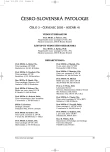Imunohistochemická studie mechanismů apoptózy a proliferace ve sliznici tenkého střeva u celiakální sprue
Immunohistochemical Study of the Apoptotic and Proliferative Mechanisms in the Intestinal Mucosa During Coeliac Disease
Mechanisms leading to morphological changes of the small intestine during coeliac disease are not yet completely recognized, however, two main processes have been suggested recently: remodelling of mucosa by matrix metalloproteinases, and mucosal atrophy by apoptosis. The aim of this study was to analyze the expression of proteins regulating apoptosis and some markers of proliferation in the mucosa of the small intestine of children with active (ACD) and latent form (LCD) of coeliac disease (CD). Intestinal biopsies of 43 children with ACD and LCD were analyzed by standard indirect immunohistochemical technique for Fas, Fas ligand (Fas-L), tissue transglutaminase (tTG), Bcl-2, Bid, glutathione S-transferase (GST), CAS 3, CAS 8, PARP, Ki-67, Topoisomerase IIa, PCNA expression. We found significantly lower numbers of Fas-expressing enterocytes in ACD patients than in LCD patients and controls. The number of Fas-positive mucosal lymphocytes was decreased in ACD when compared with LCD. Fas-L expression in enterocytes and mucosal lymphocytes was higher in ACD and LCD compared to controls.We found significantly more Bcl-2 negative lymphocytes in ACD than in LCD and controls. Bid expression in enterocytes was higher in LCD compared to ACD and controls. In intraepithelial lymphocytes, there was higher Bid expression in LCD than in ACD and controls compared to expression in mucosal lymphocytes, where was found higher number of positive cells in controls than in ACD and LCD. Expression of CAS 8 in mucosal lymphocytes was significantly higher in ACD compared to LCD. The expression of tTG in extracellular matrix and basal lamina was significantly higher in LCD and ACD when compared to controls. Expression of tTG was higher in the group of ACD and LCD in the enterocytes and in the lymphocytes. Our findings showed that Fas/Fas-L, Bcl-2, and CAS 8 may be involved in modulation of apoptosis during CD. Increased apoptotic elimination of IEL in LCD can partially explain preservation of the normal villous architecture. Increased tTG expression may be an early sign of increased apoptosis or may be related to its role in CD pathogenesis.
Key words:
coeliac disease – apoptosis- Fas/Fas-L – Cas 3,8 – PARP
Autoři:
S. Lísová 1; J. Ehrmann 1; A. Kolek 2; E. Sedláková 1; Z. Kolář 1
Působiště autorů:
Ústav patologie LF UP a FN, Olomouc
1; Dětská klinika FN, Olomouc
2
Vyšlo v časopise:
Čes.-slov. Patol., 41, 2005, No. 3, p. 85-93
Kategorie:
Původní práce
Souhrn
Mechanismy vedoucí k morfologickým změnám sliznice tenkého střeva při glutenové enteropatii nebyly dosud plně objasněny, ačkoliv se v současné době uvažuje o dvou hlavních mechanismech: remodelaci sliznice matrixovými metaloproteinázami a atrofii sliznice způsobené zvýšenou apoptózou. Cílem naší studie bylo analyzovat expresi proteinů regulujících apoptózu a některých proliferačních markerů ve sliznici tenkého střeva u dětí s aktivní (AC) a latentní formou (LC) celiakální sprue (CS). Pomocí nepřímé imunohistochemie byla u střevních biopsií 43 dětí s aktivní a latentní formou CS detekována a analyzována exprese Fas, Fas ligandy (Fas-L), tkáňové transglutaminázy (tTG), Bcl-2, Bid, glutathion S-transferázy (GST), CAS 3, CAS 8, PARP, Ki-67, Topoisomerázy IIa a PCNA. Nalezli jsme signifikantně nižší hodnoty exprese Fas na enterocytech u pacientů s AC než u pacientů s LC a kontrol. Počet Fas-pozitivních slizničních lymfocytů byl snížen u AC v porovnání s LC. Exprese Fas-L v enterocytech a slizničních lymfocytech byla vyšší u AC a LC v porovnání s kontrolami. Nalezli jsme signifikantně více Bcl-2 negativních lymfocytů u AC než u LC a kontrol. Exprese Bid v enterocytech byla vyšší u LC v porovnání s AC a kontrolami. V intraepiteliálních lymfocytech (IEL) byla též vyšší exprese Bid u LC než u AC a kontrol a na rozdíl od lymfocytů lamina propria, kde největší počet buněk exprimujících Bid byl nalezen u kontrol. Exprese CAS 8 byla signifikantně vyšší v kryptálních lymfocytech u AC ve srovnání s LC. Exprese tTG v extracelulární matrix a bazální membráně byla signifikantně vyšší u LC a AC ve srovnání s kontrolami. Exprese tTG byla vyšší ve skupině AC i LC než u kontrol, jak v enterocytech tak i ve slizničních lymfocytech. Naše nálezy ukazují možnost spoluúčasti Fas/Fas-L, Bcl-2 a CAS 8 na regulaci apoptózy u CS. Zvýšená apoptotická eliminace IEL u LC může částečně vysvětlit zachování normální vilózní morfologie střevní sliznice. Zvýšená exprese tTG může být časným znakem zvýšené apoptózy a může být v souladu s její rolí v patogenezi CS.
Klíčová slova:
celiakie – apoptóza – Fas/Fas-L – CAS 3,8 – PARP
Štítky
Patologie Soudní lékařství ToxikologieČlánek vyšel v časopise
Česko-slovenská patologie

2005 Číslo 3
Nejčtenější v tomto čísle
- Prsní žláza – vývoj a nádory
- Cystitis emphysematosa, způsobená Clostridium perfringens – lokální infekce u nemocného s generalizovaným melanomem
- Adenomatoidný tumor pravej nadobličky: kazuistika
- Imunohistochemická studie mechanismů apoptózy a proliferace ve sliznici tenkého střeva u celiakální sprue
